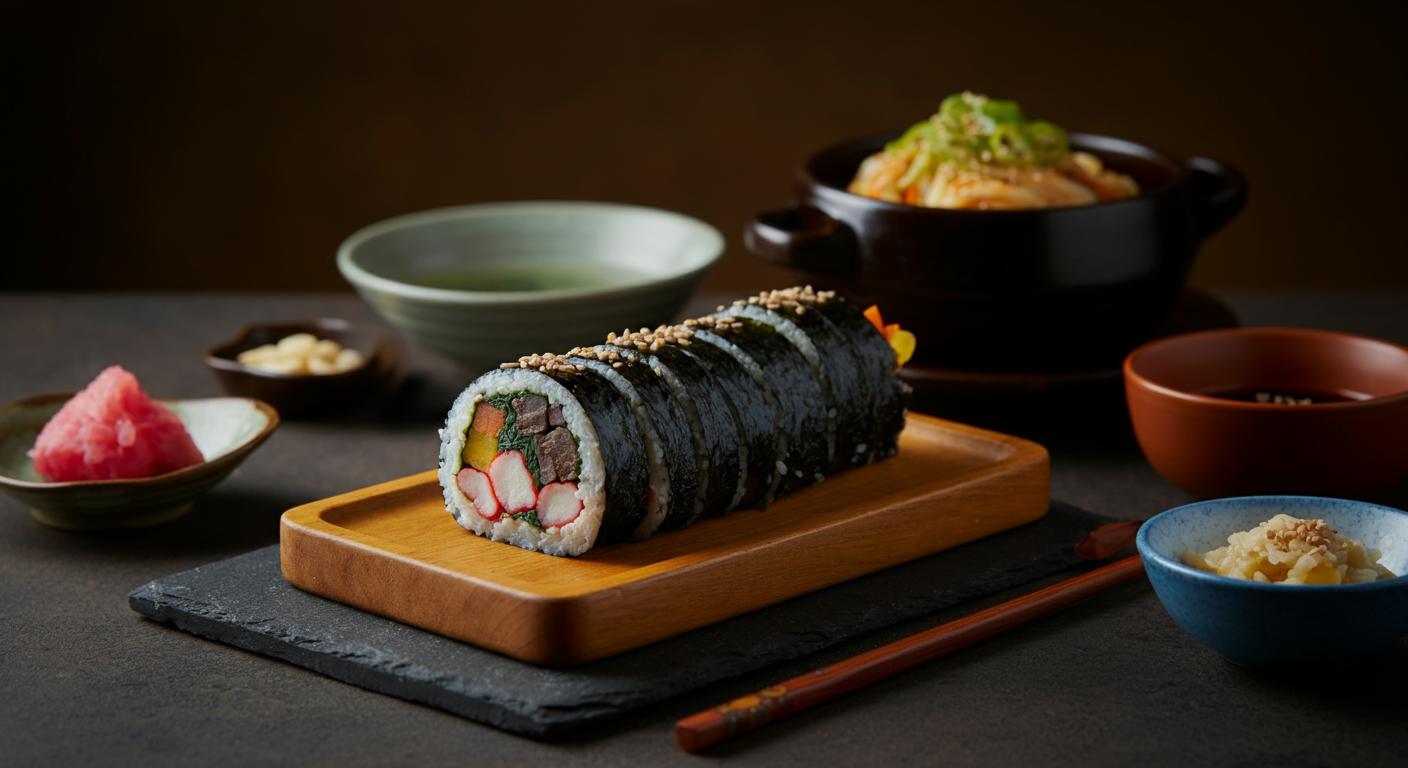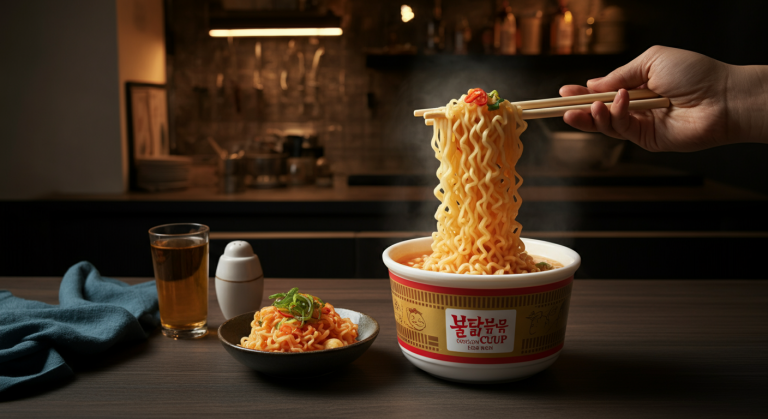Gimbob: Korea’s Healing Snack, Ramen’s Soulmate

Annyeonghaseyo, K-VIBE fam! As someone who’s spent their life immersed in the heart of Korean culture, both its vibrant traditions and its dynamic modern pulse, I’ve seen firsthand how our food has captured hearts worldwide. You’ve probably swooned over K-drama characters sharing a spicy bowl of ramyeon (라면) or seen your favorite K-pop idols munching on something that looks like a colorful sushi roll. Well, today, we’re diving deep into that iconic, humble, yet utterly indispensable dish: Gimbob (김밥). This isn’t just food; it’s a feeling, a memory, a warm hug in roll form.
You might be wondering, with all the sensational Korean dishes making waves globally – from crispy Korean fried chicken (치킨) to fiery Tteokbokki (떡볶이) – why focus on something that looks so simple? Trust me on this: in Korea, Gimbob (김밥) holds a uniquely revered status, often standing shoulder-to-shoulder with ramyeon (라면) as the ultimate comfort food for the busy and the hungry. It’s more than just a quick bite; it’s a source of genuine healing (힐링) and solace, a reliable friend when you need energy and comfort. Growing up, Gimbob (김밥) was synonymous with excitement – school picnics (소풍), family road trips, or even just a quick, delicious meal when my mom was busy. It was always there, a colorful, neatly rolled package promising a burst of flavors and a sense of well-being. It’s truly a “healing snack (힐링 간식)” for our demanding, fast-paced lives.
For international fans who’ve fallen in love with Korea through its dramas and music, understanding Gimbob (김밥) is like unlocking a secret level of cultural appreciation. It connects the dots between a mother’s thoughtful packed lunch, a student’s late-night study fuel, and even a quick, satisfying meal for a hardworking idol. So, roll up your sleeves (pun intended!) as we unwrap the fascinating story of Gimbob (김밥) – its origins, its cultural significance, and why it remains an absolute staple in every Korean’s heart.
Gimbob (김밥): More Than Just a Roll – A Culinary Hug for the Soul
Let’s start with the basics for those who might be new to this delightful dish. At its core, Gimbob (김밥) is a dish made from steamed white rice (밥, bap) and various ingredients, rolled in sheets of dried seaweed (김, gim) and served in bite-sized slices. While it might visually resemble Japanese sushi rolls, Gimbob (김밥) has its own distinct identity and flavor profile, primarily characterized by the seasoned rice (often with sesame oil and salt) and the absence of raw fish (though some variations do exist now!).
The beauty of Gimbob (김밥) lies in its versatility and its meticulous assembly. Imagine a vibrant tableau: thinly sliced carrots, blanched spinach, savory stir-fried burdock root (우엉, woo-eong), yellow pickled radish (단무지, danmuji), fluffy egg strips, and often a protein like ham, beef (불고기, bulgogi), or tuna (참치, chamchi). Each ingredient is individually seasoned and prepared with care, reflecting the 정성 (jeongseong) – the heartfelt effort and sincerity – that goes into Korean cooking. This isn’t just throwing things together; it’s a careful orchestration of flavors, textures, and colors, all wrapped snugly in seaweed. The result? A balanced, satisfying, and utterly delicious bite that captures so many essential Korean flavors in one neat package.
For me, Gimbob (김밥) isn’t just food; it’s a vessel of memories. I vividly recall my mother waking up before dawn on school picnic (소풍) days. The clatter of pots, the fragrant smell of sesame oil, and the rhythmic sound of her chopping vegetables filled our home. She would carefully lay out the bamboo mat (김발, gimbal), spread the warm rice, arrange the colorful fillings, and then, with expert precision, roll everything into a tight, perfect cylinder. Opening that lunchbox at school, seeing those perfectly cut Gimbob (김밥) slices, was pure joy. It wasn’t just lunch; it was her love (정, jeong) rolled up and sent with me. This personal touch, this deep connection to care, makes Gimbob (김밥) a true healing food (힐링푸드) in Korea.
The Ubiquity of Gimbob (김밥) in Korean Life: From Schoolyards to Office Desks
Did you know that Gimbob (김밥) is often called the “national food” of Korea, not in an official sense like Kimchi (김치), but in terms of its sheer prevalence and beloved status? From bustling city centers to quiet suburban neighborhoods, you’ll find Gimbob (김밥) everywhere. It’s the quintessential 간편식 (ganpyeonsik), a simple, convenient meal that caters to Korea’s famously fast-paced lifestyle, often termed 빨리빨리 (bbali-bbali) culture.
Consider the humble yet mighty 김밥천국 (Kimbap Cheonguk), or “Gimbob Heaven.” These ubiquitous eateries, found on nearly every street corner, offer an incredibly diverse menu, but their namesake Gimbob (김밥) remains the star. They embody the spirit of Gimbob (김밥) – quick, affordable, and always satisfying. For students rushing between classes, office workers grabbing a speedy lunch, or even late-night study sessions (야식, yasik), Gimbob (김밥) is the go-to choice. It provides sustained energy and comfort without weighing you down, making it the ideal companion for busy schedules.
You’ve likely seen Gimbob (김밥) in your favorite K-dramas too! Think of characters in “Reply 1988” sharing a simple Gimbob (김밥) meal with friends, or busy doctors in “Hospital Playlist” grabbing a quick roll during their demanding shifts. These scenes aren’t just for show; they perfectly capture the reality of Gimbob (김밥)’s role in Korean daily life – a reliable source of comfort and sustenance, always there when you need a little pick-me-up or a moment of respite.
The Dynamic Duo: Gimbob (김밥) and Ramen (라면) – A Match Made in Culinary Heaven
If Gimbob (김밥) is a warm, comforting hug, then ramyeon (라면) is its fiery, exhilarating partner in crime. In Korea, these two aren’t just dishes; they’re an iconic pairing, a culinary power couple that creates a symphony of flavors and sensations. You might have seen characters in K-dramas ask, “라면 먹고 갈래?” (ramyeon meokgo gallae? – “Want to come over for ramen?”), a phrase that has become a subtle, playful invitation. But trust me, in many cases, that invitation tacitly includes Gimbob (김밥) as well! It’s simply the perfect accompaniment, the ultimate pairing for a truly satisfying meal.
Why are they so inseparable? It’s all about balance and contrast. Ramyeon (라면) is typically hot, spicy, and soupy, with its springy noodles providing a delightful chew. Gimbob (김밥), on the other hand, is mild, savory, and dry, with a medley of textures from its various fillings and the satisfying crunch of seaweed. When you take a bite of savory Gimbob (김밥) and then slurp a mouthful of spicy ramyeon (라면) broth, it creates an explosion of flavors and sensations that is utterly addictive. The Gimbob (김밥) soaks up a little of the spicy broth, making each bite even more flavorful, while also providing a cooling counterpoint to the heat.
This pairing isn’t just about taste; it’s about the experience. It’s the go-to meal for students pulling all-nighters, friends catching up late in a convenience store (편의점, pyeon-uijeom), or families enjoying a casual weekend lunch. It’s a meal that requires no fuss, just pure, unadulterated satisfaction. This cultural phenomenon makes Gimbob (김밥) and ramyeon (라면) more than just food; they are truly 위로의 음식 (wiro-ui eumshik) – food that brings comfort and consolation.
A Symphony of Flavors: Why This Pairing Just Works
Let’s dive deeper into the magic of this combination. Imagine: you pop a slice of Gimbob (김밥) into your mouth. You taste the nutty sesame oil on the rice, the subtle sweetness of the carrots, the earthy flavor of the spinach, the tangy crunch of the pickled radish (단무지). It’s a harmonious blend of textures and tastes. Then, you take a hearty slurp of piping hot, spicy ramyeon (라면). The heat hits you, the umami flavor of the broth awakens your senses, and the noodles provide a comforting warmth. The Gimbob (김밥) acts as a perfect palate cleanser and a mild, starchy anchor, making the spicy ramen even more enjoyable.
This perfect synergy is why you’ll rarely see Gimbob (김밥) eaten alone in many Korean casual dining settings, especially at places like Kimbap Cheonguk (김밥천국). They are designed to complement each other. And the variety of Gimbob (김밥) available only enhances this experience. Beyond the classic, you can find:
- 참치김밥 (Chamchi Gimbob): Tuna Gimbob, featuring a creamy, savory tuna salad.
- 치즈김밥 (Chijeu Gimbob): Cheese Gimbob, with a slice of cheese that melts slightly with the warmth of the rice, adding a creamy richness.
- 누드김밥 (Nude Gimbob): “Naked” Gimbob, where the rice is on the outside and the seaweed on the inside, often with a sprinkle of sesame seeds.
- 꼬마김밥 (Kkoma Gimbob): Mini Gimbob, smaller, thinner rolls perfect for a quick snack or for kids.
Each offers a slightly different nuance to pair with your favorite ramyeon (라면), ensuring that the combination never gets old. It’s a testament to the 손맛 (son-mat) – the unique, delicious taste that comes from someone’s skillful, often homemade, cooking – that elevates even these simple ingredients into something extraordinary. This pairing isn’t just a meal; it’s a testament to Korean culinary ingenuity, offering maximum comfort and flavor with minimal fuss.
Gimbob (김밥) as a Symbol of Korean Resilience and Jeong (정)
Beyond its delicious taste and convenient nature, Gimbob (김밥) embodies deeper cultural values that resonate strongly in Korea. It’s a symbol of resilience, a nod to the nation’s ability to create something nourishing and wholesome even in the busiest of times. It’s also a powerful representation of 정 (jeong), that uniquely Korean concept of deep affection, connection, and emotional bond that transcends simple friendship.
Think about its role during significant national or community events. Gimbob (김밥) is often prepared and shared at protests, volunteer gatherings, or during arduous work, providing quick energy (기운, giun) and a sense of solidarity. It’s easy to make in large quantities, portable, and universally loved, making it the perfect food to share when people come together for a common cause. This act of sharing, of providing sustenance and comfort to others, is a direct expression of jeong (정). My mother, for example, would always pack extra Gimbob (김밥) for my friends on our school trips, a small but significant gesture of care that built bonds and created lasting memories. It’s a silent yet powerful way of showing, “I care about you; please eat well and stay strong.”
Gimbob (김밥) also subtly connects to 눈치 (noonchi), the Korean art of understanding unspoken cues and social dynamics. Offering Gimbob (김밥) to someone who looks busy or tired, or subtly preparing it for a group without being asked, demonstrates a keen noonchi (눈치) – an empathetic awareness of others’ needs. It’s a gesture that says, “I see you, I understand you’re busy, and I want to provide you with some comfort (위안, wii-an).” This makes Gimbob (김밥) not just a food item, but a facilitator of human connection and a humble yet profound source of healing (힐링) in the fabric of Korean society.
The Evolution of Gimbob (김밥): From Simple Rolls to Gourmet Delights
While Gimbob (김밥) holds firm to its traditional roots, it’s also a food that has elegantly adapted to modern tastes and global influences. What started as a simple, home-style roll has evolved into a diverse culinary category. Today, you can find gourmet Gimbob (김밥) shops offering innovative fillings like spicy pork (제육김밥, jeyuk gimbob), shrimp tempura, cream cheese, or even avocado. These contemporary twists reflect Korea’s dynamic food scene and its willingness to innovate while honoring tradition. The surge of the 한류 (Hallyu), or Korean Wave, has also propelled Gimbob (김밥) onto the international stage, with more people seeking it out after seeing it in K-dramas or experiencing it through K-pop content.
The global embrace of Gimbob (김밥) is truly a 대박 (daebak) phenomenon – an awesome, jackpot-level success! It speaks to its universal appeal: it’s healthy, customizable, portable, and incredibly satisfying. From being a quick bite for busy Koreans, it’s now becoming a global sensation, recognized for its simplicity, flavor, and the cultural warmth it carries. This evolution highlights Gimbob (김밥)’s enduring charm and its ability to connect with diverse palates, proving that a food deeply rooted in tradition can also be at the forefront of modern culinary trends.
So, there you have it – the incredible journey and profound significance of Gimbob (김밥). It’s far more than just rice and seaweed rolled together; it’s a vibrant tapestry woven with the threads of everyday life, family love, community spirit, and national resilience. For those busy mornings, quick lunches, or even late-night cravings after a long day, Gimbob (김밥) stands as a testament to Korean culture’s ability to offer simple, yet profound, comfort and healing.
Next time you watch a K-drama and see a character enjoying Gimbob (김밥), or if you ever get the chance to try it yourself, remember the stories we’ve shared today. Remember the mothers who packed them with jeong (정), the students who relied on them for energy, and the workers who found solace in their convenient goodness. It’s a dish that embodies the very essence of a healing snack (힐링 간식), providing nourishment and a gentle embrace to anyone who needs it.
While many say “치킨은 사랑이야 (Chikin-eun sarang-iya – Chicken is love),” after exploring the depths of Gimbob (김밥), I’d argue that Gimbob (김밥) is quiet devotion, a steady friend that always has your back. So, go on, seek out some delicious Gimbob (김밥) and perhaps a bowl of hot ramyeon (라면), and experience a true taste of Korean comfort for yourself. You won’t regret it. 그러게요! (Geureogeyo! – Indeed!)




![Dear Mom, I Can’t Come to Dinner Because Baek Sa-eon Just [SPOILER] and I Need 3-5 Business Days to Recover](https://k-vibe.net/wp-content/uploads/2025/08/kvibe-thumbnail-20250829-215006-768x419.png)
